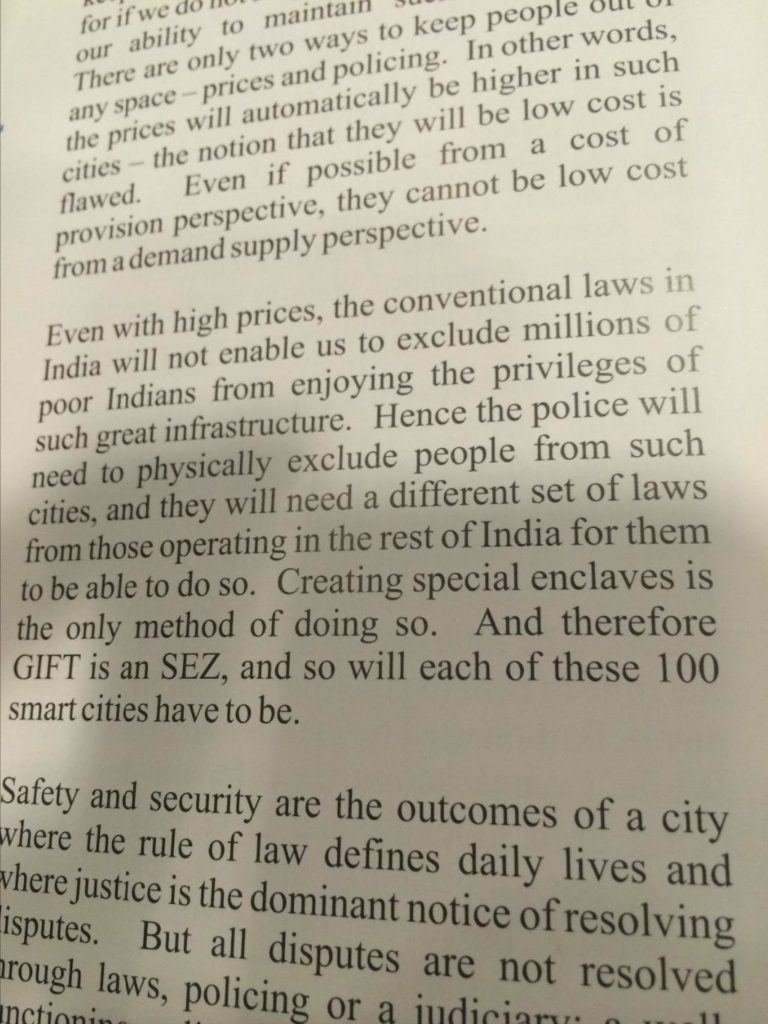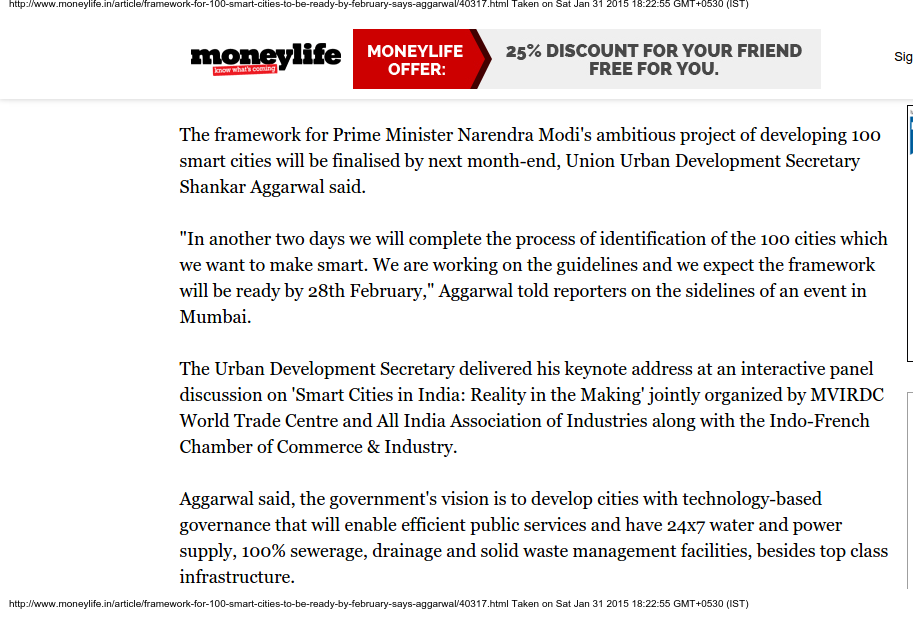There was a interactive panel discussion in Mumbai WTC on the 29th of January 2015 organized by World Trade Centre (WTC) and All India Association of Industries (AIAI) in collaboration with the Indo-France Chamber of Commerce and Industries (IFCCI). It was to discuss ‘Smart Cities in India: Reality in the Making’.
Dignitaries on the stage included Mr. Sanjay Sethi (IAS) (Additional Metropolitan Commissioner-I, MMRDA), Ms. Laura Prasad (Secretary General, IFCCI), Dr. Laveesh Bhandari (Founder and Chief Economist, Indicus Analytics Pvt. Ltd.), Mr. Vijay Kalantri (President, AIAI and Vice Chairman, MVIRDC WTC), Mr. Shankar Aggarwal (IAS, Secretary, Ministry of Urban Development Government of India), Mr. Dilip Shekdar (Chief Architect, Naya Raipur Development Authority), Mr. Ravi Kant Malhan (Director, Head Business Development: Smart Cities and Special Projects, Schneider Electric India), Capt. Somesh Batra (Vice Chairman, MVIRDC WTC) and Mr. Abhishek Lodha (Managing Director, Lodha Group).
A journalist, Shruti Ravindran who had attended it, tweeted a photo of a shocking quote from a brochure ‘Smart Cities in India: Reality in the Making’ released during this event.

The quote in the above photo says:
…There are only two ways to keep people out of any space – prices and policing. In other words, the prices will automatically be higher in such cities – the notion that they will be low cost is flawed. Even if possible from a cost provision perspective, they cannot be low cost from a demand supply perspective.
Even with high prices, the conventional laws in India will not enable us to exclude millions of poor Indians from enjoying the privileges of such great infrastructure. Hence the police will need to physically exclude people from such cities, and they will need a different set of laws from those operating in the rest of India for them to be able to do so. Creating special enclaves is the only method of doing so. And therefore GIFT is an SEZ and so will each of these 100 smart cities have to be.
(excerpt from an article by Laveesh Bhandari, Founder and Chief Economist at Indicus Analytics Pvt Ltd)
So let me get this right. The government will be used to empty land to build smart cities in the name of developing the country. It will be called “inclusive development”. And the smart cities built on this land will be for the rich – by design. And we are talking of a hundred cities, displacing god knows how many people. The police of the land will be used “on the tax payer’s money” (as these hotshots like to call it) to keep the poor out of these cities using laws OTHER THAN INDIAN LAWS.
Am I the only one being reminded of Arundhati Roy’s infamous quote that earned her the anger of the oh-so-innocent middle classes? Here it is, if you don’t remember. And she said this in 2007.
We have a growing middle class, being reared on a diet of radical consumerism and aggressive greed. Unlike industrializing western countries which had colonies from which to plunder resources and generate slave labour to feed this process, we have to colonize ourselves, our own nether parts. We’ve begun to eat our own limbs. The greed that is being generated (and marketed as a value interchangeable with nationalism) can only be sated by grabbing land, water and resources from the vulnerable. What we’re witnessing is the most successful secessionist struggle ever waged in Independent India. The secession of the middle and upper classes from the rest of the country.
~ Arundhati Roy
This could be considered the impractical fantasy of rich men (albeit very rich men and sponsors of the ruling party behind this government), but the brochure also carries an introductory message from Shankar Aggarwal, IAS, Union Ministry of Urban Development, GOVERNMENT OF INDIA, not to mention him being personally present there and meeting journalists on the sidelines to announce the Framework for 100 smart cities to be ready by February.

Here are some relevant excerpts from the brochure including the message from Shankar Aggarwal, the program schedule of the event, including names of speakers, the profile of the author Dr. Laveesh Bhandari, the article itself, and another article on GIFT, which is referenced in this article as a model. Excerpts from Smart Cities in India: Reality in the Making
Given the opaque manner in which this government operates, as well as dramatic undermining of protections of local interests and environment through ordinances, such views should be a cause of alarm for citizens, if the much heralded development is going to actually be displacement on a massive scale, disenfranchisement of local populations and their explicit exclusion from the “growth story” while the rich use the country’s power to get land for their shangri-las, use the country’s resources “24/7” (can this ever be promised to those who will be displaced to create these “enclaves”?) and use the country’s police force to protect what will essentially be elite facilities barred to the common masses through special laws created to protect the elite.
I imagine, the elites will also only be paying for their actual residences and the cost of creating these havens for them will also have to be borne by the country.
Is this development or colonization of India by the rich? The Gujarat model is all set to exploit India as well. All we need are new signboards, “Poor citizens and dogs not allowed”


Why dont you put up the entire brochure. It seems like the author has purposefully taken a para and placed it out of context.
The entire article is available in the attached pdf download along with the content of other relevant texts. Have you read it? The photo is of a quote that amply demonstrates the problem. I fail to see this “out of context” you speak of.
Apart from the usual fear mongering, this would be an excellent system. It is quite similar to China’s hukou system which doesn’t allow mostly poor people from coming into their cities. If this was followed by india, Mumbai wouldn’t have been the shithole that it is today. Development would have been faster, urban areas would have had the quality of life and less of our professionals would have migrated overseas. True it sounds alarming that poor people are excluded, but this actually fastracks development in the country and there is a far better chance that the poor people will be elevated out of poverty faster like what China has done. It will be a boon for newer cities if they can be planned perfectly without slums. Also when i say poor people are excluded it doesn’t mean the ones who can afford to buy a place in the new city and this place doesn’t have to be expensive, it could be low cost housing. On the face of it, it does seem cruel but nothing can make the development go faster and reach India’s poor than making our cities world class and attracting the talent and entrepreneurs which we are losing to emigration. With China reaching some 160 or so cities with more than a million population and the infrastructure in each city is just amazing, it can be seen how urbanisation is working there. Such fear mongering will lead us nowhere.
I think it is one paragraph in one brochure which has a misplaced idea. I highly doubt GIFT city is being developed with the intention of displacing low income people and including only wealthy people. Smart cities are being developed in order to address the need for basic infrastructure like land water shelter etc. It is to curb the crowding of our established big cities and thus a strain on their infrastructure.
The gujarat model is mainly used in the context of electricity. It is the only state to be self sufficient in power needs and have a positive financials in its distribution business. It has achieved this by implementing feeder separation in rural areas. While pure play agriculture will receive subsidized to free power the rural households will pay for power Creating a win win for all.
Again i highly doubt the concept of smart city has been created to keep poor out. That would be a little dramatic. Logically it can never work even if a few despotic individuals want it to happen.
Damn. I don’t know whether to be outraged at this or just accept the reality. Such things are so common these days that I’m not even surprised. Observing the Indian middle class’ mentality, I wouldn’t be shocked if they support this with all their might.
Would it be possible to request the journalist concerned to post a copy of the full text of the brochure, or Laveesh Bhandari’s speech/article.
I have requested, but she doesn’t seem to have the tools needed – it is a large brochure. The file linked for download has the relevant pages including full text of Laveesh Bhandari’s article.
The journalist’s name is Shruti Ravindran. That should have been mentioned if you’re using the photograph she took.
She had initially not wanted to be mentioned, which is why I had simply said “a journalist”. I spoke with her again and she is now attributed. Thank you for caring for correct attribution of sources.